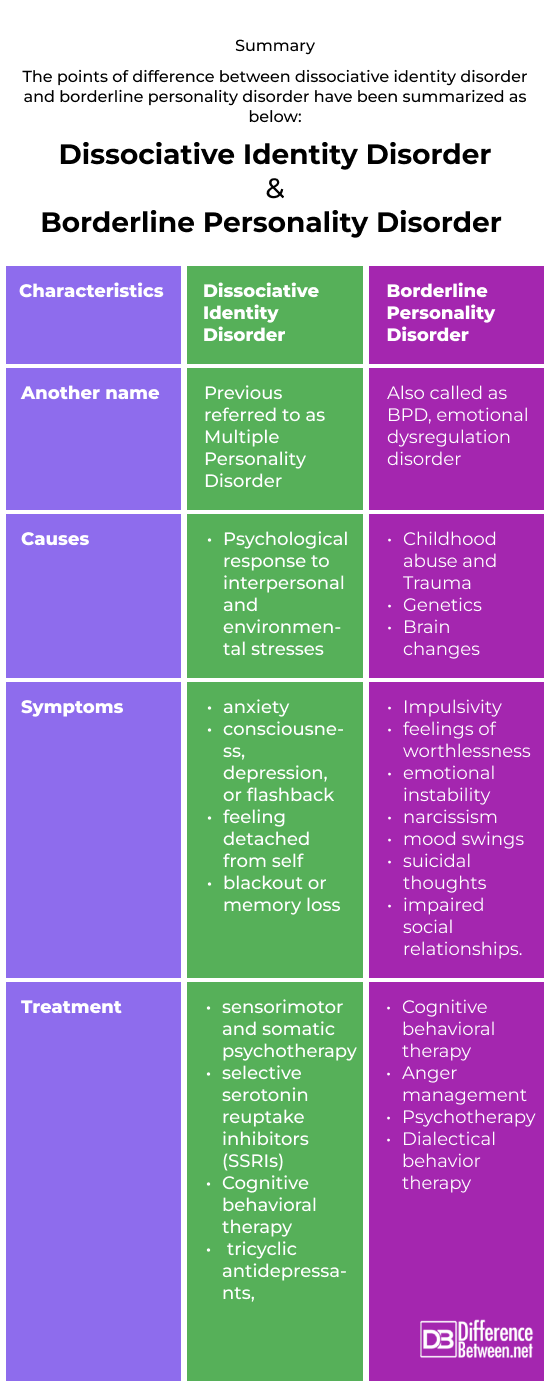Difference Between Dissociative Identity Disorder and Borderline Personality Disorder
The condition known as dissociative identity disorder (DID), formerly known as multiple personality disorder, is defined by the existence of two or more separate identity states that regulate a person’s actions, perceptions, and memories. These identity states are commonly called “alters,” and the inability to remember significant personal information is a common symptom.
The personality illness known as borderline personality disorder (BPD) is typified by widespread volatility in behaviour, mood, interpersonal interactions, and self-image. People diagnosed with borderline personality disorder (BPD) frequently feel strong, fluctuating emotions, struggle with self-identity, and encounter problems with self-worth.
Similarity
Both have similar appearing symptoms.

Dissociative Identity Disorder
- Issues with memory, identity, emotion, perception, behaviour, and sense of self are common in dissociative disorders.
- Dissociative symptoms have the ability to impair all aspects of mental health.
- Amnesia or memory loss are examples of dissociative symptoms, as is the sensation of detachment or being outside of one’s body.
- Past trauma experiences are commonly linked to dissociative disorders.

Borderline Personality Disorder
One mental condition that significantly impairs a person’s capacity to control their emotions is borderline personality disorder. This loss of emotional control can make someone more impulsive, have an adverse effect on their self-esteem, and damage their relationships with other people.
Difference between Dissociative Identity Disorder and Borderline Personality Disorder
Identity and memory
Dissociative Identity Disorder
The existence of discrete identity states or alters, each with a particular manner of interacting with the outside world, is fundamental to DID. A crucial component is amnesia in between these identity states.
Borderline Personality Disorder
While identity disruptions are possible in BPD patients, the condition is not distinguished by the existence of discrete identity states, as in DID patients. In BPD, memory gaps are usually not associated with the existence of distinct identities, but rather with emotional discomfort or dissociation.
Emotional Regulation
Dissociative Identity Disorder
Emotional imbalance may be evident in DID, but it is frequently linked to the distinct identity states and their individual emotional reactions.
Borderline Personality Disorder
Emotional instability is a fundamental characteristic of BPD. People with BPD might encounter strong and varying emotions, challenges in managing emotions, and an increased susceptibility to perceived desertion.
Interpersonal Relationships
Dissociative Identity Disorder
The existence of various identity states can influence relationships, and transitions between alters can influence an individual’s interactions with others.
Borderline Personality Disorder
People diagnosed with BPD might face difficulties in maintaining strong and stable relationships, frequently characterized by a fear of being left, having extreme admiration, and devaluing others.
Trauma and Etiology
Dissociative Identity Disorder
Frequently associated with a background of significant trauma, particularly during childhood, as a means of dealing with overpowering encounters.
Borderline Personality Disorder
Trauma, specifically trauma experienced in the early years, is also a prevailing element in the emergence of BPD. Nevertheless, not all individuals with BPD possess a trauma-related background.
Summary
The points of difference between dissociative identity disorder and borderline personality disorder have been summarized as below:

FAQ:
Is borderline personality disorder similar to dissociative identity disorder?
There is a common association between DID and severe trauma, and the different personality states often serve as coping mechanisms. A significant difference between BPD and BPD is that the disorder is primarily characterized by emotional dysregulation and difficulties in relationships.
Can someone have borderline personality disorder and dissociative identity disorder?
It’s crucial to remember that dissociative identity disorder (DID) and borderline personality disorder (BPD) are two separate mental health diseases with different diagnostic criteria, even if it is theoretically conceivable for someone to have both.
The hallmarks of borderline personality disorder are widespread patterns of instability in emotions, emotions, and interpersonal interactions. BPD sufferers may exhibit impulsive behaviours, a skewed self-image, intense and unstable relationships, and emotional instability.
In contrast, dissociative identity disorder is characterised by the coexistence of two or more separate identity states that influence an individual’s memory, awareness, and behaviour. Individuals suffering with dissociative identity disorder (DID) may encounter memory lapses, a disconnection between their behaviour and self-concept, and the existence of several personality states.
Although issues with identity and emotional control may be present in both illnesses, these conditions are usually treated as separate diagnoses. Nonetheless, people can have co-occurring mental health disorders. It is not unusual for a person suffering from one mental illness to concurrently exhibit symptoms of another.
What is the key difference between multiple personality disorder and dissociative identity disorder?
Now known as dissociative identity disorder (DID), the phrase “multiple personality disorder” (MPD) is an outdated and less accurate word used to refer to a condition. In the Diagnostic and Statistical Manual of Mental Disorders, dissociative identity disorder is a more modern and commonly recognized term.
A person with dissociative identity disorder has two or more separate identity states that influence their behaviour, awareness, and memory. These identity states, often called “alters,” might differ greatly in terms of age, gender, personality, and even physical attributes. Memory lapses frequently accompany these identity state shifts, and each identity state may have a distinct manner of relating to the outside world.
In conclusion, “dissociative identity disorder” is a more appropriate and current title for the disease than “multiple personality disorder,” which is an outmoded phrase. The word has changed to reflect a more accurate knowledge of the disorder and a departure from the sensationalised and deceptive meanings attached to the previous term.
What is the difference between DID and split personality disorder?
One common phrase for DID is divided personality. DID was once referred to as multiple personality disorder. DID sufferers have two or more unique personas. They show up as more complex than simple mood or characteristic swings.
How to tell if someone is faking dissociative identity disorder?
People who imitate or fake DID as a result of factitious disorder usually lie, exaggerate symptoms (especially when they are witnessed), attribute symptoms to negative behaviour, and frequently display little discomfort in relation to their apparent diagnosis.
What are the 3 main symptoms of dissociative disorder?
- having a sense of disconnection from both the outside world and yourself.
- forgetting certain dates, occasions, and private information.
- feeling unsure of your identity.
- possessing several unique identities.
- experiencing little to no discomfort in the body.
- Difference Between Global Warming and Greenhouse Effect - May 18, 2024
- Difference Between Vaccination and Immunization - March 3, 2024
- Difference Between Selective Mutism and Autism - February 25, 2024
Search DifferenceBetween.net :
Leave a Response
References :
[0]Dorahy, M. J., Brand, B. L., Şar, V., Krüger, C., Stavropoulos, P., Martínez-Taboas, A., ... & Middleton, W. (2014). Dissociative identity disorder: An empirical overview. Australian & New Zealand Journal of Psychiatry, 48(5), 402-417.
[1]Jørgensen, C. R. (2010). Invited essay: Identity and borderline personality disorder. Journal of Personality Disorders, 24(3), 344-364.
[2]Middleton, W., & Butler, J. (1998). Dissociative identity disorder: an Australian series. Australian & New Zealand Journal of Psychiatry, 32(6), 794-804.
[3]Image credit: https://www.canva.com/photos/MAEvM-tpBok-mental-disorder-psychiatry-split-personality-woman-with-black-and-white-face-mask/
[4]Image credit: https://www.canva.com/photos/MACvdAL-kDE-young-man-visiting-psychiatrist-doctor-for-consultation/
